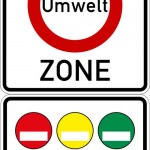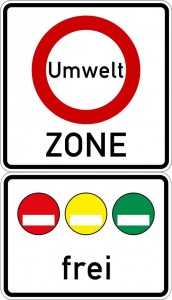
(English below)
Die Pressemitteilung des Instituts Mobile Zukunft, Johannes Hübner:
Die Wirkungslosigkeit der sog. “Umweltzonen” ist nach den vorliegenden Daten der betroffenen Kommunen seit 2010 erwiesen. Die Messverfahren wurden nicht verfeinert und man bleibt Beweise der Wirksamkeit schuldig. Deshalb fordern viele Organisationen und Automobilclubs ein Ende dieser Maßnahme, die mit erheblichen Nachteilen für viele Bürger verbunden ist.
Zur Begründung:
1. Die Atmosphäre besteht zu 78% aus Stickstoff und zu 21% Sauerstoff. Im verbliebenen Restprozentist Co2 als Spurenelement mit einem Gesamtanteil von 0,038% enthalten. Nicht einmal 10% dieser Menge wird nach übereinstimmender Meinung aller Fachleute von menschlichen Aktivitäten verursacht, d.h. selbst wenn der Mensch all seine Aktivitäten einstellt, würden nicht einmal 4 Tausendstel der Co2-Emissionen wegfallen. Der Einfluss des Straßenverkehrs beträgt wiederum ebenfalls 10% dieser 4 Tausendstel, d.h. in Umweltzonen könnte lediglich mit einer Reduzierung von Co2 um 4 Zehntausendstel Prozent gerechnet werden.
2. Der Feinstaub-Anteil ist in den Umweltzonen nicht gesunken, sondern so wie in Berlin, Frankfurt oder Stuttgart sogar gestiegen. Mangels geeigneter Messverfahren ist die Ursache noch unbekannt, atmosphärische Phänomene werden von den bestehenden Anlagen nur unzureichend erfasst und überregional nicht miteinander verknüpft und analysiert. Nicht verkehrliche Einflüsse werden nicht erkannt: In Frankfurt etwa sind im Bereich des Messpunkts Friedberger Landstraße (Nordend)zwischen 2007 und Ende 2010 fast 6.000 Holzpellet- und Kamin-Öfen in Betrieb genommen worden- ein Zusammenhang scheint wahrscheinlich.
3. Laut UBA und anderen Quellen werden 12% des Feinstaubs vom Straßenverkehr emittiert. Oldtimer haben einen Verkehrsanteil von nicht einmal 0,03%. Mit der Verbannung klassischer Fahrzeuge aus Umweltzonen könnten folglich im Idealfall 0,003% der Feinstaubemissionen vermieden werden. Diese Menge liegt unterhalb der Nachweisgrenze. Dieselpartikel älterer Fahrzeuge sind zudem gröber als Feinstaub.
4. Einfluss und Wirkungsweise von Co2 in Atmosphäre und Weltklima sind immer noch weitgehend unerforscht, Schaden oder Nutzen nicht klar beziffert. In den letzten 10 Jahren hat sich weltweit weder die mittlere Jahrs-Durchschnittstemperatur signifikant erhöht, noch sind Meeresspiegel gestiegen. Die Ursachen für die verstärkten Wetterphänomene im äquatorialen Meeresgürtel sind nicht erwiesen und dem anthropogenen Anteil an der Atmosphäre deshalb nicht klar zuzuordnen.
Die Einrichtung und Umsetzung der bestehenden Umweltzonen hat bislang erhebliche gesamtwirtschaftliche Belastungen zu Ungunsten der Steuerzahler ausgelöst. Angesichts der nachgewiesenen Wirkungslosigkeit der sog. “Umweltzonen” sind diese Kosten und die damit verbundenen Nachteile für Fahrzeughalter, Anlieger, Wirtschaft und Bewohner der Umweltzonen nicht länger vertretbar. Die Maßnahmen gefährden zudem Arbeitsplätze und Wirtschaftsbetriebe und entwerten das Eigentum zahlreicher Fahrzeughalter. Dies ist eine gesetzwidrige Ungleichbehandlung.
Der in manchen Kommunen praktizierte Versuch der positiven Beeinflussung der von der EU geforderten Messergebnisse durch Verlagerung des Verkehrs um die Messpunkte herum, um Sanktionen gegen diejeweiligen Kommunen zu vermeiden, hat sich als untauglich erwiesen und ist zudem rechtlich höchstzweifelhaft.
Regierung, Parteien und politische Mandatsträger sind gefordert, sich in ihrem Wirkungsbereich auch auf EU-Ebene für die Aufhebung der sog. “Umweltzonen” einzusetzen und eine Ausweitung dieser nachweislich ungeeigneten, aber sehr teuren Maßnahme zu unterbinden.
V.i.S.d.P.:
Joh. Hübner,
Institut Mobile Zukunft IMZU,
Klassikstadt Frankfurt,
Orber Straße 4,
60386 Frankfurt am Main,
autoconsult@web.de
—–
Institute for mobile future: “environmental zones” to be discontinued – proven to be ineffective
Attached please find the press release of the “Institut Mobile Zukunft” (Institute for mobile future), translation by Amicale:
The ineffectiveness of the so-called “environmental zones” is proven by the data available to the affected communities since 2010. The measurement procedures were not refined, and evidence of the effectiveness is not presented. Therefore, many organizations and car clubs demand an end to this measure which is associated with considerable disadvantages for many citizens.
Justification:
1. The atmosphere consists of 78% nitrogen and 21% oxygen. The remaining percentage contains CO2 in a trace element and to a total proportion of 0.038%. Not even 10% of this amount is caused by human activities according to matching opinion of all professionals, thus even if humanity ceases CO2 production all of its activities, not even 4 thousandths of CO2 emissions would be eliminated. The impact of road traffic is also in turn 10% of 4 thousandths, i.e. in environmental zones could only be expected to reduce CO2 by 4 ten-thousandths percent.
2. The proportion of dust particle did not decrease in the emission zones, but as in Berlin, Frankfurt, Stuttgart it instead increased. Because of the lack of appropriate measurement methods, the cause remains unknown, atmospheric phenomena are inadequately covered by existing systems and are not regionally linked and analyzed. Not traffic-related impacts are not taken into consideration: In Frankfurt, for example, within the range of the measurement point at Friedberger Landstrasse (northern Frankfurt) between 2007 and the end of 2010 nearly 6,000 wood pellet stoves and fireplace have been put into operations – a linkage of that emission seems likely.
3. According to “Umweltbundesamt” (UBA, National Environment Association) and other sources 12% of particle emission is originated from road traffic. Vintage vehicles in Germany have a market share of less than 0.03%. With the banishment of vintage cars from environmental zones therefore 0.003% of the particle emissions could be avoided in the ideal case. This amount is below the detection limit. Diesel particle filters installed within older vehicles are also rather coarser than fine.
4. Influence and effect of CO2 in the atmosphere and global climate are still largely unexplored, no clear harm or benefit has been estimated. In the last 10 years, neither the medium-year average global temperature has increased significantly, nor did the sea level rise. The reasons for the increased weather phenomena in the equatorial ocean belts are not proven and not clearly attributable to the anthropogenic share of the atmosphere.
The establishment and implementation of the existing environmental zones has been triggered considerably an overall economic burden to the detriment of taxpayers. Given the proven ineffectiveness of the so-called “environmental zones” these costs and the associated disadvantages for car owners, residents, business, and residents of the environmental zones are no longer justifiable. Moreover, the measures threaten jobs and economy and devalue the ownership of many vehicle owners. This is an unlawful discrimination.
The practiced attempt executed in some cities to positively influence the measurement results required by the EU, by shifting traffic away from the measuring points to avoid sanctions against the cities, has proven to be ineffective and is also legally highly dubious.
Government, political parties and elected representatives are called upon at EU level for the abolition of the so-called “environmental zones” within their area of responsibility, and to prevent an extension of this demonstrably inadequate, but very expensive measure.
Press release initiator and contact:
Johannes Hübner,
Institut Mobile Zukunft IMZU,
Klassikstadt Frankfurt,
Orber Straße 4,
60386 Frankfurt am Main,
autoconsult@web.de

